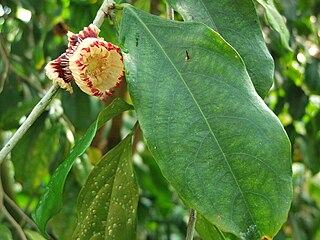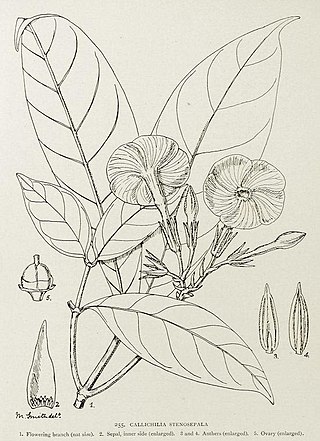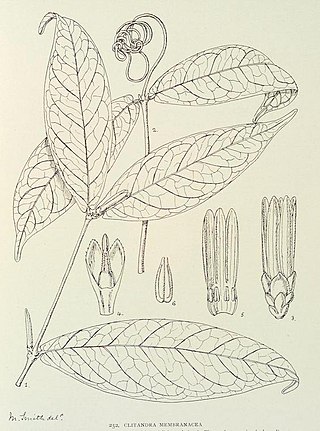Discoglypremna is a plant genus of the family Euphorbiaceae first described as a genus in 1911. It contains only one known species, Discoglypremna caloneura, native to tropical Africa.

Napoleonaea is a genus of woody plant in the family Lecythidaceae first described as a genus in 1804, the same year its namesake crowned himself Emperor of the French. The genus is native to Africa.
Belonophora is a genus of flowering plants in the family Rubiaceae. It is found in Tropical Africa from Senegal east to Sudan and south to Angola. It was described by Joseph Dalton Hooker in 1873.
Eremospatha is a genus of climbing flowering plants in the palm family found in tropical Africa. These rattans are uncommon in cultivation and poorly understood by taxonomists. Closely related to Laccosperma, they are differentiated by the near complete absence of bracts and bracteoles. The name is from Greek meaning "without a spathe".

Cercestis is a genus of flowering plants in the family Araceae. The species in this genus are all climbers and are endemic to Africa. At intervals along the stem they produce long leafless shoots called flagella. Many of the species in Cersestis show signs of fenestration.
Chasmopodium is a genus of African plants in the grass family.

Papilio chrapkowskoides, the broadly green-banded swallowtail, is a species of swallowtail butterfly from the genus Papilio that is found in the Republic of the Congo, Uganda, Rwanda, Burundi, Tanzania, Guinea, Sierra Leone, Liberia, Ivory Coast, Ghana, Togo, Benin, Nigeria, Cameroon, Gabon, the Democratic Republic of the Congo, and Angola.

Belenois calypso, the Calypso white or Calypso caper white, is a butterfly in the family Pieridae. It is found in Senegal, the Gambia, Guinea-Bissau, Guinea, Sierra Leone, Liberia, Ivory Coast, Burkina Faso, Ghana, Togo, Benin, Nigeria, Cameroon, the Republic of the Congo, the Central African Republic, the Democratic Republic of the Congo, Angola, Uganda, Kenya and Tanzania. The habitat consists of forests. The species occasionally migrates.

Palla violinitens, the violet-banded palla, is a butterfly in the family Nymphalidae. It is found in Guinea, Sierra Leone, Liberia, Ivory Coast, Ghana, Benin, Nigeria, Cameroon, the Republic of the Congo, the Central African Republic, Angola, the Democratic Republic of the Congo and Uganda. The habitat consists of primary lowland evergreen forests.

Amauris tartarea, the monk or dusky friar, is a butterfly in the family Nymphalidae. It is found in Guinea, Burkina Faso, Sierra Leone, Liberia, Ivory Coast, Ghana, Togo, Benin, Nigeria, Cameroon, Equatorial Guinea, Gabon, the Republic of the Congo, the Central African Republic, Angola, the Democratic Republic of the Congo, Sudan, Uganda, Kenya, Tanzania, Malawi, Zambia, Botswana and Namibia. The habitat consists of various types of forests.
Craterispermum is a genus of flowering plants in the family Rubiaceae. It contains 16 species that occur in tropical Africa and Seychelles. It is the only genus in the tribe Craterispermeae, of which the divergence time is estimated at 34.8 million years ago.

Spialia ploetzi, the forest grizzled skipper, is a butterfly in the family Hesperiidae. It is found in Guinea-Bissau, Guinea, Sierra Leone, Liberia, Ivory Coast, Ghana, Togo, Benin, Nigeria, Cameroon, Gabon, the Republic of the Congo, Angola, the Democratic Republic of the Congo, Uganda, Kenya and Tanzania. The habitat consists of forests.

Callichilia is a genus of plant in the family Apocynaceae, native to tropical Africa.
Motandra is a genus of plant in the family Apocynaceae native to tropical Africa. As of August 2013 the World Checklist of Selected Plant Families recognises 3 species:
- Motandra guineensis(Thonn.) A.DC. - widespread from Liberia to Sudan and south to Angola
- Motandra lujaeDe Wild. & T.Durand - Gabon, Congo, Cabinda, Equatorial Guinea, Zaire
- Motandra poecilophyllaWernham - Gabon, Congo, Equatorial Guinea, Cameroon
- Motandra erlangeriK.Schum = Oncinotis tenuilobaStapf
- Motandra glabrataBaill. = Oncinotis glabrata(Baill.) Stapf ex Hiern
- Motandra viridifloraK.Schum. = Baissea viridiflora(K.Schum.) de Kruif
- Motandra welwitschianaBaill. = Oncinotis hirtaOliv.

Pleiocarpa is a genus of plant in the family Apocynaceae first described as a genus in 1876. It is native to tropical Africa from Senegal to Tanzania and south to Zimbabwe. As of August 2013 the World Checklist of Selected Plant Families recognises 6 species:
- Pleiocarpa bicarpellataStapf - Cabinda, Cameroon, Republic of the Congo, Gabon, Democratic Republic of the Congo, Kenya
- Pleiocarpa brevistylaOmino - Gabon
- Pleiocarpa muticaBenth. - Ghana, Ivory Coast, Liberia, Sierra Leone, Nigeria, Cameroon, Gabon, Central African Republic, Republic of the Congo
- Pleiocarpa picralimoides(Pichon) Omino - Cabinda, Republic of the Congo, Gabon
- Pleiocarpa pycnantha(K.Schum) Stapf - widespread across most of tropical Africa
- Pleiocarpa rostrataBenth. - Nigeria, Cameroon, Gabon
- Pleiocarpa camerunensis(K.Schum. ex Hallier f.) Stapf = Hunteria camerunensisK.Schum. ex Hallier f.
- Pleiocarpa hockiiDe Wild. - Acokanthera oppositifolia(Lam.) Codd
- Pleiocarpa simii(Stapf) Stapf ex Hutch. & Dalziel = Hunteria simii(Stapf) H.Huber

Englerophytum is a group of trees in the family Sapotaceae described as a genus in 1914.

Clitandra is a genus of flowering plants in the family Apocynaceae, first described as a genus in 1849. A total of 46 names have been coined since that time for species, subspecies, and varieties within the genus, but most of them have been transferred to other genera. The genus is currently regarded as containing only one species, Clitandra cymulosa, native to tropical Africa.
Dictyophleba is a genus of flowering plants in the family Apocynaceae first described as a genus in 1898. It is native to Africa and to the Comoros Islands in the Indian Ocean.
- Dictyophleba leonensis(Stapf) Pichon - West Africa from Cameroon to Liberia
- Dictyophleba lucida(K.Schum.) Pierre - Comoros, central + southern Africa from Nigeria east to Tanzania and south to Zimbabwe
- Dictyophleba ochracea(K.Schum. ex Hallier f.) Pichon - central Africa from Nigeria to Zaire
- Dictyophleba rudensHepper - Cameroon
- Dictyophleba setosaB.de Hoogh - Cameroon, Gabon
- Dictyophleba stipulosa(S.Moore ex Wernham) Pichon - from Ivory Coast to Congo-Brazzaville
Orthopichonia is a genus of plants in the family Apocynaceae, first described as a genus in 1953. It was initially given the name Orthandra, but this turned out to be an illegitimate homonym. Orthopichonia is native to Africa.
Vahadenia is a genus of flowering plants in the family Apocynaceae, first described as a genus in 1902. It is native to tropical Africa.










